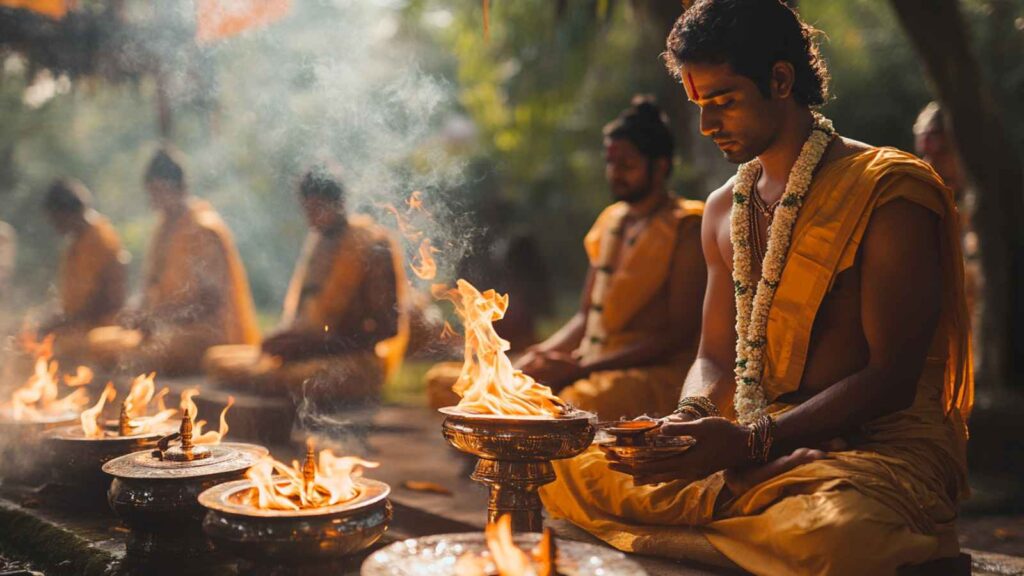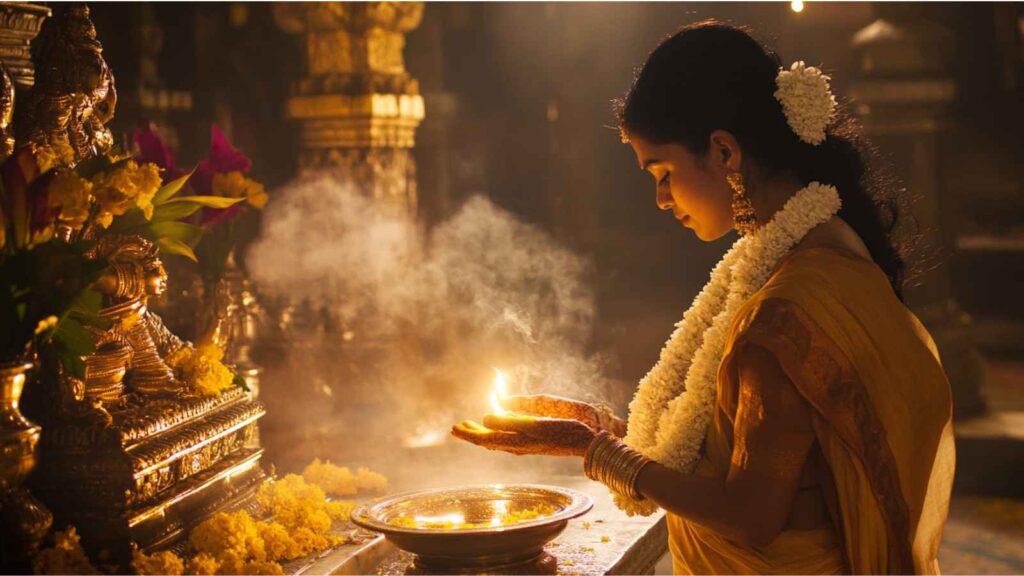Upanayana (Sacred Thread Ceremony): A Journey into the Sacred Samskara of Initiation
Upanayana is one of the most pivotal samskaras (sacred life-cycle rituals) in Hinduism, marking the formal initiation of a young individual into the spiritual and educational journey. Often referred to as the “sacred thread ceremony,” Upanayana signifies the transition from childhood to the stage of learning (brahmacharya) and is imbued with deep philosophical, ritualistic, and cultural significance. Rooted in ancient scriptures like the Vedas, Upanishads, and Grihya Sutras, this ceremony not only instills the values of discipline and duty but also serves as a spiritual awakening, setting the individual on a lifelong path of knowledge and self-realization.
Read More About Ritual & Practices
This comprehensive guide explores the multifaceted dimensions of the Upanayana samskara—from its foundational scriptures and ritual procedures to its symbolic meaning in the modern context. We also examine how temple visits play an essential role in enhancing the spiritual aura of the ceremony. Three iconic temples are profiled for their association with Upanayana blessings, detailing their exact locations, historical backgrounds, architectural highlights, and visitor experiences. Additionally, a robust framework for creating engaging AI-generated visuals is provided to help capture the essence of this sacred ritual and boost SEO performance.
Foundational Scriptures and Spiritual Guidance
The Vedas and Upanishads
The Vedas, comprising the Rigveda, Yajurveda, Samaveda, and Atharvaveda, are the oldest scriptures in Hinduism. They lay the groundwork for the cosmic order (ṛta) and the eternal cycle of creation, preservation, and dissolution. While the Vedas primarily focus on hymns and rituals, they also establish the importance of initiating the mind and spirit into higher realms of knowledge—a principle that underpins the Upanayana ceremony.
The Upanishads, which delve into the nature of the self (Atman) and the ultimate reality (Brahman), further reinforce the significance of education and self-realization. These texts emphasize that every individual is an expression of the divine and that true knowledge leads to liberation (moksha). The Upanayana ritual, therefore, is not just a physical ceremony but a metaphysical one—symbolizing the awakening of the inner light and the journey toward spiritual enlightenment.
Grihya Sutras and Dharmashastras
The Grihya Sutras provide detailed instructions for domestic rituals and ceremonies, including Upanayana. These texts prescribe the specific mantras, procedures, and symbolic acts to be performed during the initiation, ensuring that the ritual is conducted with precision and reverence. The Grihya Sutras emphasize the importance of purity, discipline, and adherence to ritualistic norms, which are essential for harnessing the transformative energy of the ceremony.
Complementing the Grihya Sutras, the Dharmashastras, such as the Manusmriti, outline the moral and ethical duties of an individual. They stress that the Upanayana samskara is not only about imparting knowledge but also about instilling a sense of duty (dharma) and responsibility toward oneself and society. This dual focus on education and ethical conduct underscores the transformative power of the sacred thread ceremony.
Regional Traditions and Tamil Literary Contributions
In addition to pan-Indian scriptures, regional texts and ancient Tamil literature provide a rich context for understanding the Upanayana ritual. Sangam literature and works like the Thirukkural celebrate the virtues of learning, discipline, and the sanctity of the teacher-student relationship. These regional traditions highlight that the sacred thread is more than a symbol; it is a commitment to uphold the values of knowledge, humility, and service to society.
“The sacred thread is the bond that ties the individual to the eternal wisdom of the cosmos—a symbol of duty, learning, and the unending quest for truth.”
– Traditional Sanskrit Proverb
The Ritual of Upanayana: A Sacred Initiation

Upanayana is typically performed for boys, although some communities also conduct similar rites for girls. The ceremony marks the beginning of formal education (brahmacharya) and the spiritual journey toward self-realization. It is a moment of profound transition where the child is introduced to the study of sacred texts, disciplined learning, and the practice of meditation and reflection.
Key Elements of the Upanayana Ceremony
- Preparation and Purification:
Prior to the ceremony, the child and the family undergo a period of cleansing and purification. This preparation includes ritual baths, the wearing of clean attire, and the recitation of specific purificatory mantras. These practices symbolize the removal of any impurities and the readiness to embark on a new phase of life. - The Sacred Thread (Yajnopavita):
Central to the Upanayana is the donning of the sacred thread, known as the yajnopavita. This thread, typically made of cotton, is a tangible symbol of the individual’s initiation into the Vedic tradition. The act of wearing the sacred thread signifies that the person is now a student (brahmachari) and is ready to receive spiritual knowledge from a guru (teacher). - Mantra Recitation and Ritual Acts:
The ceremony is conducted by a learned priest who chants mantras from the Vedas and Grihya Sutras. These mantras invoke divine blessings and mark the transition from the sheltered life of infancy to the disciplined path of learning and self-discipline. Ritual acts, such as the offering of grains and the symbolic sprinkling of water, further emphasize the themes of nourishment, purity, and renewal. - Initiation into Education:
With the completion of the Upanayana, the child formally becomes a brahmachari, signifying the beginning of their educational journey. This transition is celebrated with the promise of acquiring knowledge and wisdom, which will guide the individual throughout life.
The Symbolism Behind Upanayana
- Spiritual Awakening:
The Upanayana ritual is a profound act of initiation that awakens the inner consciousness of the individual. It signifies the moment when the mind is opened to the teachings of the Vedas, setting the stage for a lifelong pursuit of knowledge and truth. - Commitment to Dharma:
By accepting the sacred thread, the individual makes a commitment to uphold dharma (righteousness) and to live a life of discipline, honesty, and moral integrity. - Continuity of Tradition:
The ritual not only reinforces the individual’s connection to their personal and familial heritage but also ensures the transmission of ancient wisdom from one generation to the next.
Iconic Temples Associated with Upanayana Blessings

While the Upanayana ceremony is primarily performed in the home, many families visit temples soon after the ritual to seek additional blessings for the child. These temple visits are an integral part of the samskara, reinforcing the sacred connection between the individual and the divine. Below, we profile three iconic temples renowned for their spiritual ambiance, rich history, and architectural magnificence.
1. Sree Venkateswara Temple, Tirumala, Andhra Pradesh
Location:
Sree Venkateswara Temple
Address: Tirumala, Tirupati district, Andhra Pradesh, India
Historical Background:
Sree Venkateswara Temple is one of the most revered pilgrimage destinations in India, with a history that spans centuries. Dedicated to Lord Venkateswara, an incarnation of Vishnu, the temple is famed for its divine aura and the myriad blessings it bestows upon its visitors. Families often visit the temple after performing Upanayana to seek blessings for the child’s future and academic success. The temple’s enduring legacy of devotion and spiritual enlightenment makes it an ideal destination for initiating the journey of learning and self-realization.
Architectural Highlights:
- Dravidian Grandeur:
The temple is a masterpiece of Dravidian architecture, featuring towering gopurams (gateway towers), intricately carved pillars, and expansive halls that exude timeless elegance. - Intricate Sculptures and Carvings:
The temple walls are adorned with detailed carvings depicting mythological narratives, celestial beings, and deities, showcasing the artistic brilliance of ancient Indian craftsmen. - Harmonious Blend of Tradition and Modernity:
While retaining its ancient charm, the temple has been modernized to accommodate millions of pilgrims, offering a seamless blend of tradition and contemporary amenities.
Visitor Experience:
Visitors to Sree Venkateswara Temple are enveloped in an atmosphere of deep spirituality and devotion. The harmonious chants, the rich fragrance of incense, and the visual spectacle of ornate architecture create an immersive experience. For families celebrating Upanayana, a visit to Tirumala is not only a pilgrimage but also an opportunity to immerse the child in a legacy of divine learning and cultural heritage.
2. Jagannath Temple, Puri, Odisha
Location:
Jagannath Temple
Address: Jagannath Temple Complex, Puri, Odisha, India
Historical Background:
The Jagannath Temple in Puri is one of the four Char Dham pilgrimage sites and a cornerstone of Vaishnavism. With roots that extend back to ancient times, the temple is dedicated to Lord Jagannath—a form of Vishnu—and is celebrated for its spiritual and cultural richness. Many families visit Jagannath Temple after Upanayana to seek the blessings of divine knowledge and protection. The temple’s historical significance and the vibrant traditions that surround it have made it a beacon of hope and spiritual guidance for countless devotees.
Architectural Highlights:
- Kalinga Architectural Style:
The temple is a stunning example of Kalinga architecture, featuring towering spires, intricately carved stone panels, and an elaborate shikhara (tower) that captures the divine presence. - Vivid Murals and Sculptures:
Detailed murals and sculptures narrate the mythological tales of Lord Jagannath, enriching the temple’s cultural narrative and spiritual ambiance. - Sacred Layout and Cosmic Harmony:
Designed according to Vastu Shastra, the temple’s layout is intended to create a harmonious flow of energy, making it an ideal sanctuary for divine blessings and spiritual rejuvenation.
Visitor Experience:
A visit to Jagannath Temple is a deeply immersive experience, where the resonating sound of temple bells, the aroma of burning incense, and the vibrant processions create a dynamic atmosphere of devotion. For families marking the Upanayana samskara, the temple offers a sanctified space to invoke blessings that fortify the child’s journey toward learning and self-discovery.
3. Meenakshi Amman Temple, Madurai, Tamil Nadu
Location:
Meenakshi Amman Temple
Address: Madurai, Tamil Nadu, India
Historical Background:
Meenakshi Amman Temple is an iconic cultural and spiritual landmark in South India. Dedicated to Goddess Meenakshi (an incarnation of Parvati) and Lord Sundareswarar (a form of Shiva), the temple has been at the heart of Tamil religious and artistic traditions for centuries. Although primarily associated with Shaivism and Shaktism, the temple also plays an essential role in the broader spectrum of Hindu samskaras. Many families visit Meenakshi Temple post-Upanayana to seek blessings that nurture the child’s spiritual and educational journey, thereby reinforcing the values of discipline, knowledge, and devotion.
Architectural Highlights:
- Dravidian Architectural Excellence:
The temple is renowned for its majestic gopurams—towering gateway towers adorned with thousands of intricate sculptures—that are among the finest examples of Dravidian architecture. - Ornate Halls and Corridors:
Elaborate mandapams (halls) and intricately carved corridors display a wealth of traditional motifs, narrative frescoes, and vibrant murals that narrate mythological stories. - Cultural and Spiritual Hub:
Beyond its religious significance, the temple is a vibrant center for festivals, music, dance, and cultural performances that celebrate the rich heritage of Tamil Nadu.
Visitor Experience:
Visitors to Meenakshi Amman Temple are often captivated by its dynamic blend of spirituality and art. The temple’s rich history, the soulful cadence of devotional songs, and the ever-present sense of divine energy provide a deeply enriching experience. For families observing Upanayana, the temple serves as a powerful symbol of cultural continuity and spiritual guidance, inspiring the child to embrace a life of learning and devotion.


